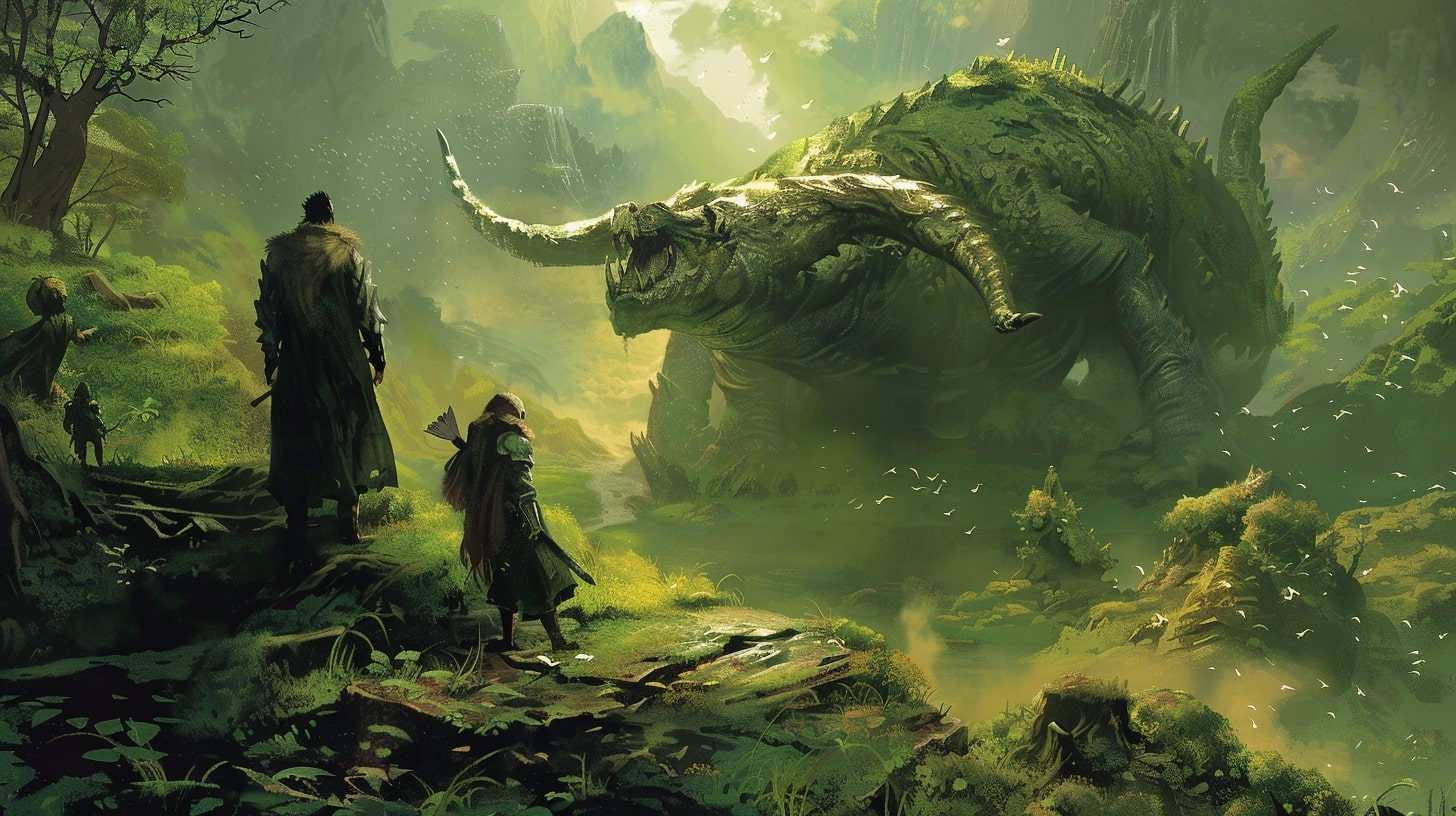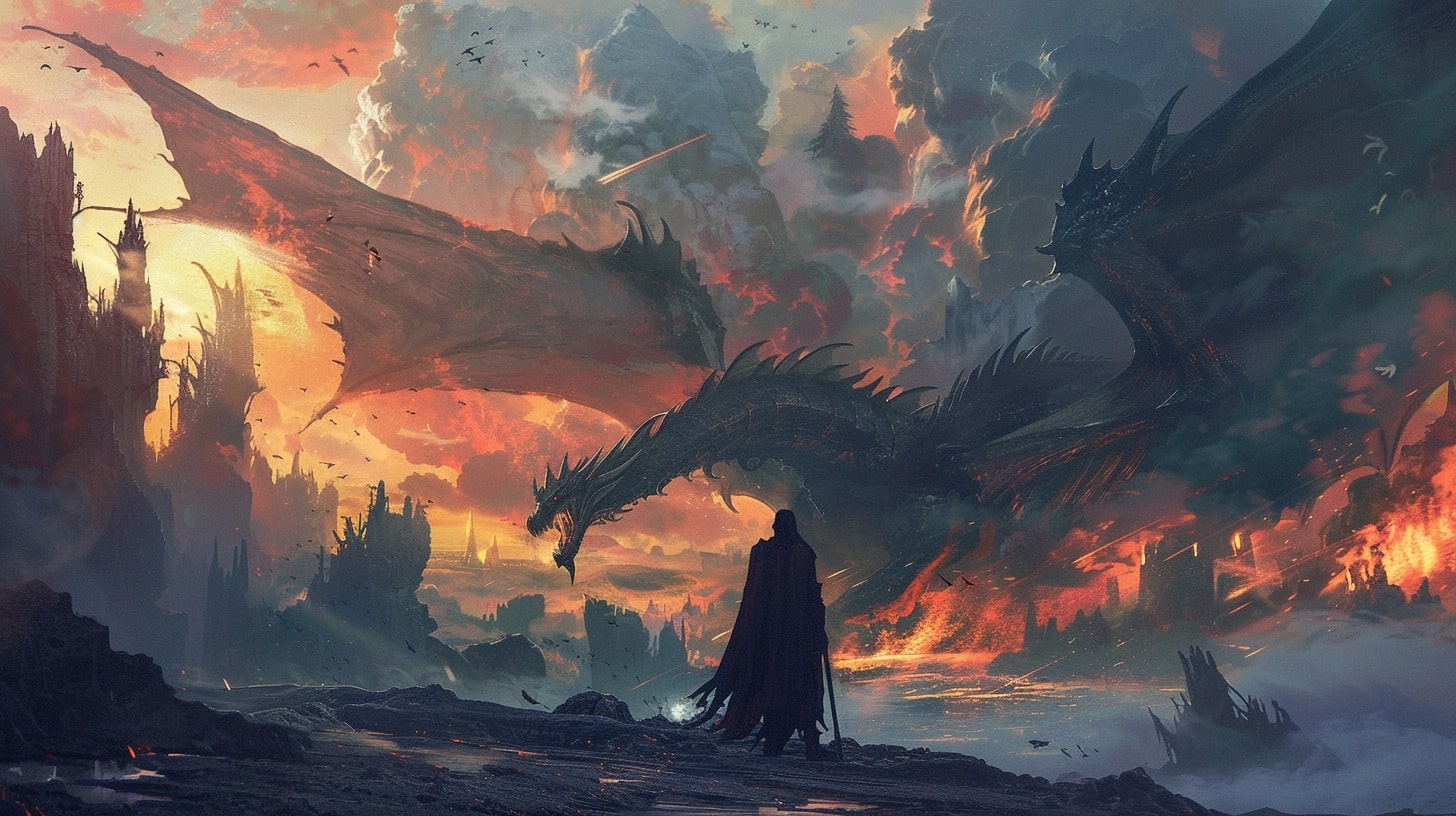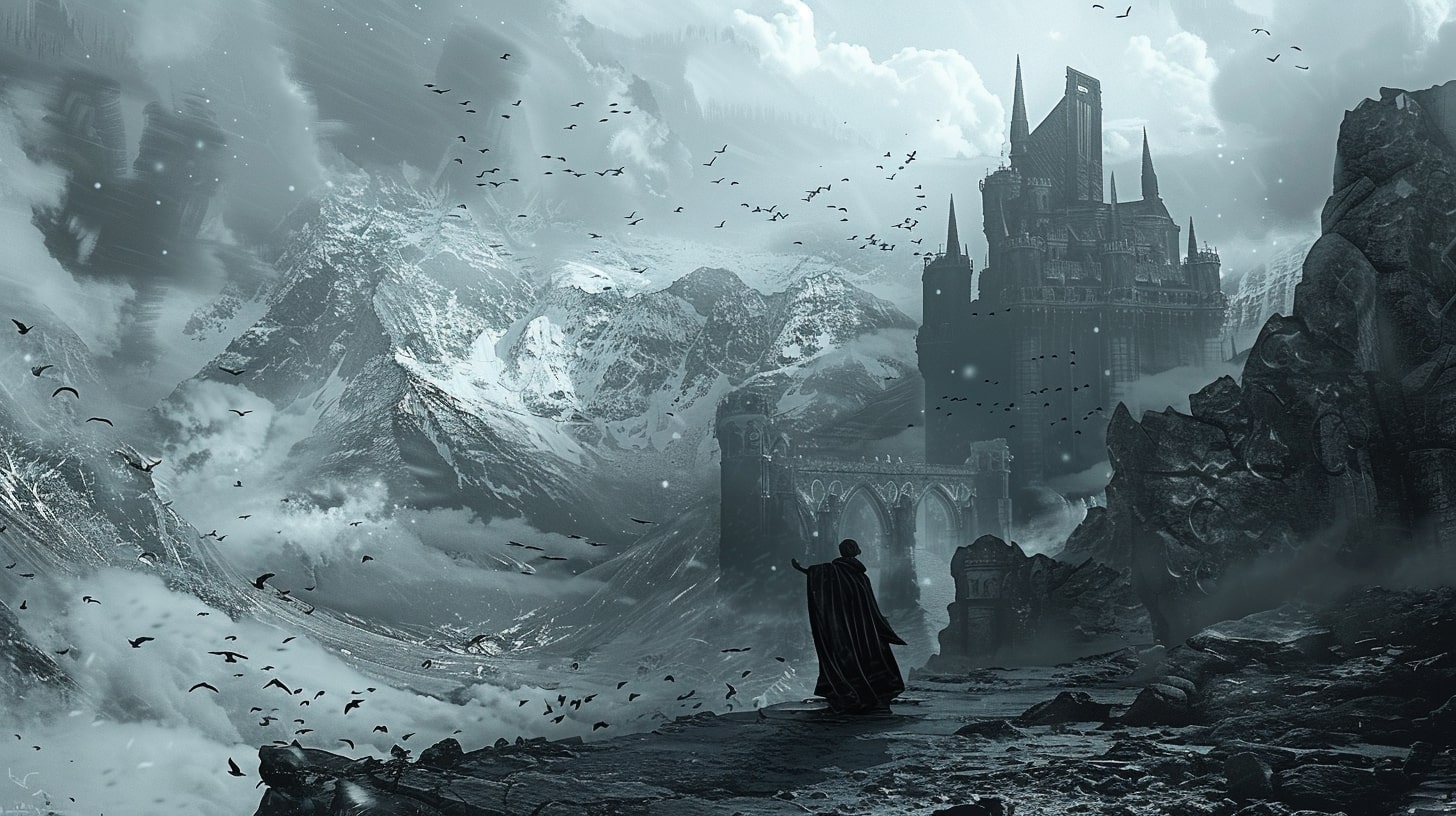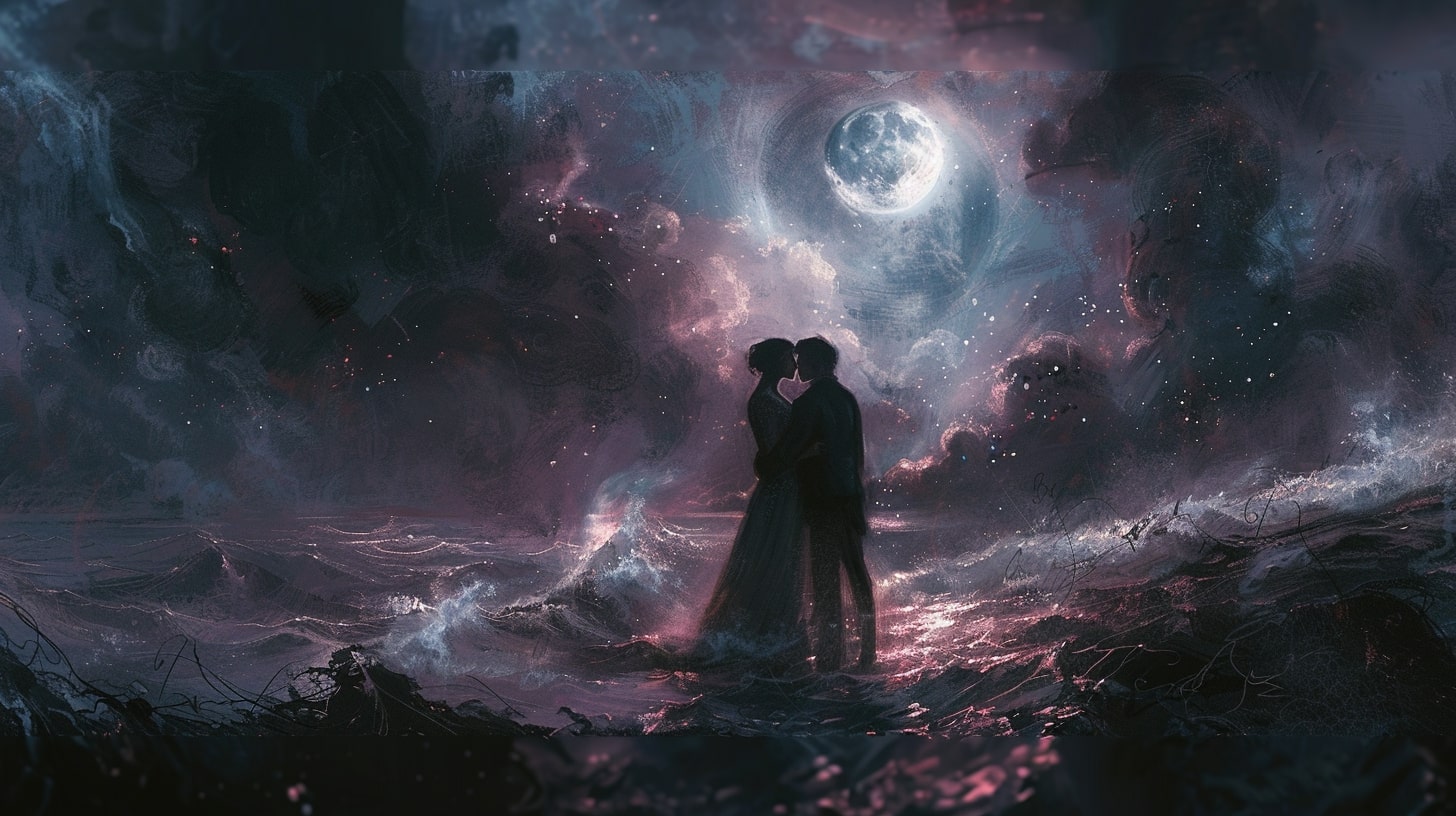Look, I get it. You've got this amazing fantasy world in your head. Epic magic systems, complex political intrigue, and characters that feel so real you could swear they're hanging out in your living room right now. But something's not quite right with your plot, is it?
Maybe you've caught yourself staring at that blank page, wondering why your story feels more like a D&D campaign gone wrong than the next Game of Thrones. Or worse, you're fifty thousand words in and realizing your plot has more holes than a dragon's swiss cheese collection.
Here's the thing about fantasy plot and structure that nobody wants to talk about. Most of us are doing it completely backwards. We're out here trying to copy Tolkien without understanding why Tolkien worked in the first place. It's like trying to build a house by starting with the paint colors.
I know because I've been there. My first fantasy novel was a disaster. I had everything - the chosen one, the prophecy, the epic quest to save the world from ultimate evil. You know what I didn't have? A story that anyone actually wanted to read.
But here's the good news. After years of banging my head against the keyboard (and trust me, those dents are still there), I figured out what makes fantasy plots actually work. Not just work - sing. The kind of plots that keep readers up until 3 AM, muttering "just one more chapter" like it's some sort of sleep-deprived prayer.
By the time you finish reading this guide, you'll know how to:
- Build a fantasy plot that doesn't feel like every other book on the shelf
- Create story structures that support your world instead of fighting against it as the best in fantasy writing do
- Make your readers care about what happens next (even if they think they know what's coming)
- Turn your cool magic system into a plot engine instead of a convenient solution machine
And the best part? You won't have to sacrifice a single awesome idea from that world you've built. We're just going to make those ideas work harder for your story.
So grab your favorite writing beverage (mine's coffee strong enough to wake a sleeping dragon), and let's fix your fantasy plot. Because your story deserves better than being another forgotten manuscript in the slush pile of generic fantasy novels.
Ready to make your plot as awesome as the world you've built? Let's dive in.

The Foundation Problem - Why Most Fantasy Plots Fall Flat
Want to know the biggest reason fantasy plots fail? It's not because the ideas are bad. It's not even because the writing sucks. It's because we're building our stories on foundations made of magic fairy dust and wishful thinking.
Let me paint you a picture. You've got this killer idea for a fantasy novel. There's a prophecy (because of course there is), some chosen one who's probably a farm boy (or farm girl if you're feeling progressive), and an evil dark lord threatening to destroy everything good and pure in the world. Sound familiar?
Here's the thing. That structure isn't inherently bad. But it's like trying to make a sandwich with only bread. Sure, technically it works, but nobody's going to line up at your restaurant for it.
The Three Deadly Sins of Fantasy Plotting
The "Prophecy Is My Plot" Problem
Remember when you first read about that prophecy in your favorite fantasy novel? How epic it felt? How it sent shivers down your spine? Yeah, that's because you didn't know it was coming. Now everyone and their magical pet cat is using prophecies as a plot crutch.
Here's what prophecies actually do to your plot structure - they kill tension. When you tell readers "this is definitely going to happen," you're basically saying "don't worry about the journey, folks!" And that journey? That's your whole damn story.
The "My Magic System Is My Plot" Trap
Listen, I love a good magic system as much as the next fantasy nerd. But if your plot consists entirely of "and then they learned a new spell that solved everything," you're not writing a story. You're writing a video game tutorial.
Your magic system should create problems, not solve them. It should be the wrench in the works, not the universal socket set that fixes everything. More on this later, because it's crucial to getting your plot structure right.
The "But My World Is So Cool" Delusion
World-building is addictive. Trust me, I get it. I once spent three weeks developing a magical postal system for a fantasy city. You know what wasn't advancing while I did that? The actual plot.
Your world is the stage, not the play. All those cool details you've created? They need to serve your plot and structure, not replace them. If your story's foundation is just "look at all this cool stuff I made up," you're going to lose readers faster than a dragon loses sheep.
The Real Foundation You Need
Here's what your fantasy plot structure actually needs to stand on:
- Characters who want something specific and personal (saving the world doesn't count - it's too big)
- Conflicts that magic can complicate but never completely solve
- Stakes that matter on both a personal and larger scale
- A structure that escalates naturally, not just because the prophecy says it should
The good news? Once you understand these foundations, you can still use all those traditional fantasy elements. But they'll work for your story instead of against it. You can have your prophecy and your chosen one and your dark lord - but they need to be the decorations on your plot structure, not the support beams.
That magical postal system I mentioned? It ended up being a perfect backdrop for a story about a character trying to reconnect with their estranged family. See how that works? The fantasy element supports the personal story, not the other way around.
In the next section, we'll dig into how to actually build these foundations into something that'll support your epic fantasy ideas without collapsing under their weight. But for now, take a hard look at your current plot structure. Is it built on solid character motivations and genuine conflicts? Or is it floating on clouds of magical convenience?
Because here's the truth - readers might come for the magic, but they stay for the story. And it's time to make yours worth staying for.

Plot Structure Basics That Actually Matter
Alright, let's talk about the Hero's Journey. No, wait - don't close the tab! I know you've probably heard about it a thousand times. But here's the thing - most people get it completely wrong, especially in fantasy.
The Hero's Journey Isn't What You Think
You know how everyone talks about the Hero's Journey like it's some kind of plot structure checklist? "Oh, did you include the Mentor? The Magic Item? The Return?" Here's the brutal truth - Joseph Campbell wasn't writing a how-to guide. He was describing patterns he found in stories that worked.
The real power of the Hero's Journey isn't in the steps. It's in understanding why these patterns resonate with readers. And it all boils down to three crucial questions that your plot structure needs to answer.
The Only Three Plot Questions That Matter
What Does Your Character Want?
Not what the prophecy says they should do. Not what the council of elders demands. What do they want? And I mean really want, deep down in their gut where the magic can't reach.
Let me give you an example. In my latest story, I had this powerful mage who could reshape reality. Know what she wanted most? To open a bakery. Not because it was her destiny, but because baking was the one thing her magic couldn't perfect. That personal want drove the entire plot structure.
What's Stopping Them?
This is where most fantasy plots go sideways. We throw in dark lords and ancient evils when the real obstacle should be something the character can't just fireball their way through.
Your obstacles need to be:
- Personal enough to hurt
- Complex enough that magic alone can't solve them
- Connected to what the character wants (not just what the plot needs)
What Happens If They Fail?
Here's where fantasy writers often reach for the "end of the world" button. But think about it - do you really care if a fictional world ends? No. You care about the people in that world.
The stakes need to matter on a personal level first. Maybe the world will end, sure. But what matters is that your character will lose something specific and meaningful to them if they fail.

Making Stakes Matter in a World With Magic
This is the tricky part. How do you create tension when your characters can throw fireballs? The secret lies in understanding the difference between power and agency.
Your character might be able to level a mountain with a wave of their hand, but can they:
- Fix a broken relationship?
- Earn someone's trust?
- Face their own fears?
- Make the right choice when both options suck?
These are the kinds of conflicts that drive good plot structure. The magic should complicate these problems, not solve them.
The Basic Plot Structure Framework
Here's what your fantasy story actually needs:
- A Clear Want
- Something personal and specific
- Not just a quest or mission
- Something the reader can understand and feel
- Escalating Obstacles
- Start with personal challenges
- Build to larger conflicts
- Each obstacle should force a meaningful choice
- Meaningful Stakes
- Personal consequences first
- Larger consequences growing from personal ones
- Clear cost of failure that readers can feel
- A Logical Progression
- Each event should lead naturally to the next
- No prophecy-ex-machina
- Choices and consequences driving the action

The Structure Test
Want to know if your plot structure works? Try this quick test. Take your main character's most powerful ability and remove it. If your story completely falls apart, you've got a plot problem.
Your story should work on a human level first. The magic, the fantasy elements, the epic scope - those should enhance the drama, not create it.
Remember that bakery-loving mage I mentioned? Her story would work even if you removed all the magic. It would be different, sure, but the core conflict - someone trying to find fulfillment outside of what they're "supposed" to do - that works in any genre.
That's how you know your plot structure is solid. The fantasy elements should be like spices in that baker's kitchen - they enhance the flavor, but they're not the whole meal.
In the next section, we'll look at specific tools for handling fantasy elements within this structure. But for now, take another look at your plot. Does it work on a human level? Would anyone care what happens if you removed all the magic?
Because if you get these basics right, all that cool fantasy stuff you've created will have something solid to stand on. And that's when your story starts to soar.
Fantasy-Specific Structure Tools
Now that we've got our basic plot structure sorted, let's talk about the fun stuff. You know, all those fantasy elements you've been dying to use. I'm going to show you how to make them work for your story instead of against it.
The Magic Cost Plotting Technique
Remember how I said magic should create problems, not solve them? Here's how to make that happen in your plot structure.
Every time your character uses magic, it should cost them something. And I'm not talking about some vague "energy drain" that they'll sleep off between chapters. I mean real costs that drive your plot forward.
Here's how to structure it:
- The Initial Problem (something personal and pressing)
- The Magical Solution (seems perfect at first)
- The True Cost (creates an even bigger problem)
- The Character Choice (magic vs alternatives)
Let me give you an example. Say your character uses magic to save their dying friend. Great. But what if that magic pulls its energy from their own life force? Now they've saved their friend but shortened their own life. Every future choice about using magic becomes a gut-wrenching decision that drives your plot.

Building Parallel Plots
One of the coolest things about fantasy is that you can run two plots side by side - the magical and the personal. Here's the structure I use:
The Personal Plot:
- Character wants something relatable
- Faces normal human obstacles
- Deals with relationships and emotions
The Magical Plot:
- Larger fantasy elements unfold
- Magical problems escalate
- World-level threats emerge
The key? These plots need to crash into each other regularly. Your character's personal choices should affect the magical situation, and vice versa. It's like braiding hair - separate strands that create one strong pattern.
Handling Multiple POVs Without Losing Momentum
Fantasy loves its multiple POVs, doesn't it? But holy crap can they mess up your plot structure if you're not careful. Here's how to handle them:
The POV Rotation Rule:
- Each POV needs its own clear want
- POV switches should happen at high tension points
- Every POV should affect at least one other POV's plot
- No POV should be skippable
Think of it like juggling. You don't just throw balls randomly - you create a pattern. Each POV should catch and throw plot threads to the others.
Making Prophecies Work Without Being Cliché
Want to use a prophecy? Fine. But let's make it interesting. Here's my favorite structure for prophecies:
- The Obvious Interpretation (what everyone thinks it means)
- The Personal Impact (how it affects your character's life)
- The Hidden Truth (what it actually means)
- The Choice Point (when your character must choose between following or defying it)
The trick? Make the prophecy about the choice, not the outcome. Your character should succeed or fail based on their decisions, not because some ancient words said they would.

The Story Layer Cake
Here's how all these elements work together in your plot structure:
Bottom Layer - Personal Stakes
- Character relationships
- Individual wants and fears
- Personal growth arc
Middle Layer - Magical Elements
- Magic system consequences
- Fantasy world problems
- Supernatural conflicts
Top Layer - Epic Scale
- Prophecy elements
- World-changing events
- Large-scale conflicts
Each layer should support the ones above it. If your epic-scale stuff isn't growing from your personal stakes, your story cake is going to collapse.
The Integration Test
Want to know if you're using these tools right? Try this:
For each major plot point, ask:
- How does this affect my character personally?
- What choice does this force them to make?
- How does this link to other plot threads?
- What new problems does this create?
If you can't answer all four questions, you might need to rework that plot point.

Making It All Work Together
The secret to making these tools work? They all need to serve your core story. Think of them like instruments in an orchestra. Your personal plot is the melody, and all these fantasy elements are the other instruments. They should enhance the tune, not drown it out.
Remember that mage who wanted to open a bakery? Her magic became a tool for exploring what success really means. The prophecy in her story? It was about someone with great power choosing a small life - but the way she interpreted "small" ended up saving her whole world.
That's how you use these tools effectively. They're not just cool features to show off - they're ways to dig deeper into your character's story.
In the next section, we'll tackle the common pitfalls that can trip you up even when you're using these tools right. But for now, take another look at your fantasy elements. Are they working with your plot structure or just sitting on top of it looking pretty?
Because when these tools are working right, they don't just make your story more magical - they make it more human too.
Common Fantasy Plot Pitfalls
Let's talk about the ways your plot can go wrong. And I mean spectacularly wrong. Like "dragon trying to parallel park" wrong. I've fallen into every single one of these traps, so consider this your map of where the quicksand is.

The "Too Much Magic" Trap
You know that feeling when you're eating something super rich and halfway through you just can't anymore? That's what happens when you stuff too much magic into your plot structure. Your story starts drowning in spells and magical solutions until readers stop caring about any of it.
I learned this one the hard way with my first novel. Every time my characters faced a problem, they learned a new spell. Need to cross a mountain? New flying spell. Enemy too tough? Secret power unlock. By chapter fifteen, my beta readers were falling asleep. Why? Because when magic solves everything, nothing matters.
The fix is simpler than you might think. Start with human problems, then let magic complicate them instead of solve them. Take my baker mage story. Sure, she could use magic to make perfect bread every time. But that's not what the story was about. It was about learning to embrace imperfection, and her magic actually made that harder, not easier.
The "Convenient Solution" Problem
This is what I call "plot magic" - not the actual magic in your world, but the magical way everything works out just right. It's the kind of plot structure that falls apart if anyone asks "but why didn't they just…"
I once wrote a whole novel where my main character could teleport. Super cool power, right? Until a reader asked why she didn't just teleport into the enemy's fortress in chapter one and end the whole conflict. Oops.
The solution isn't to nerf your magic into uselessness. Instead, make your solutions create new problems. When my baker mage used magic to save her shop from burning down, she accidentally linked her life force to the building. Sure, she saved her dream - but now she can never leave, or the whole place will crumble. That's the kind of solution that drives a story forward instead of ending it.
The "World-Ending Stakes" Burnout
Look, I get it. You want big stakes. But here's the problem - when every conflict is about saving the world, no conflict feels important. It's like trying to listen to music at maximum volume all the time. You just go numb.
Want to know why Game of Thrones worked so well before the whole White Walker thing took over? Because we cared about the characters fighting over that spiky chair more than we cared about the end of the world. The human stakes mattered more than the epic ones.
This is why my baker mage story resonated with readers even though the fate of the world wasn't hanging in the balance. When she had to choose between keeping her magic and keeping her bakery, readers felt that conflict in their gut. Because we all understand having to choose between what we're good at and what we love.

Making It All Work
Here's the truth about plot structure in fantasy - it's not about how many cool magical elements you can include. It's about how those elements serve your story. Think of your plot like a recipe. Magic isn't the main ingredient - it's the spice. Too little and your story's bland. Too much and it's inedible. Just right and it brings out all the other flavors.
When I'm revising now, I always ask myself one simple question. Would this story still be interesting without any magic? If the answer is no, I don't have a story yet - I just have a magic system looking for a home.
That baker mage story I keep mentioning? It worked because at its heart, it was about finding your own path when everyone expects something different. The magic just made her struggle more interesting and her choices harder. The plot didn't need magic to work - but the magic made it sing.
In the next section, we'll dig into advanced techniques for weaving all these elements together. But for now, take a hard look at your plot. Have you fallen into any of these traps? Be honest - we all have at some point. The trick isn't avoiding them entirely - it's recognizing when you're in one and knowing how to climb out.
Because here's the thing about plot holes - they only get bigger if you try to fill them with magic.
Advanced Structure Techniques
Now we're getting to the good stuff. These are the techniques that turn good fantasy plots into great ones. The kind that make readers miss their bus stop because they're too engrossed in your story.
Weaving Personal and Epic Stakes
You know what's better than a plot about saving the world? A plot about saving the world because it's the only way to save your little sister. Personal stakes and epic stakes aren't enemies - they're dance partners, and it's time to learn their rhythm.
Let me tell you about the best fantasy novel I never published. It had all the epic elements - ancient prophecies, world-ending threats, magical artifacts. But the real story? It was about a royal mage trying to prove to her daughter that she could be both a good mother and a powerful magic user. Every world-saving decision became a thousand times more interesting because it cost her time with her kid.
That's the secret sauce right there. Your epic fantasy plot shouldn't run parallel to the personal story - they should be so tangled together that pulling one thread unravels both.

Using Magic as a Plot Complication
Stop thinking of magic as a solution factory and start thinking of it as a problem generator. The best magic systems don't solve your plot problems - they create delicious new ones.
Remember our baker mage? Her ability to sense magic in everything meant she could create perfectly balanced flavors. Sounds great, right? But it also meant she could taste the emotional residue people left behind. Every bite of bread carried the feelings of everyone who handled the ingredients. Try running a bakery when you can taste your supplier's divorce in the flour.
That's how you use magic to drive a plot forward. Give your characters powers that make their personal struggles more complicated, not less. The best magical abilities should be like monkey's paws - be careful what you wish for.
Building Plot Twists That Actually Work
Here's the thing about plot twists in fantasy - they're not about surprising the reader. They're about making the reader feel stupid for not seeing it coming. And I mean that in the best possible way.
The best plot twist I ever wrote wasn't when I revealed the dark lord was actually the hero's father (yeah, I went there, I'm not proud of it). It was when I revealed that every magical solution my protagonist had used to help people throughout the story had actually been feeding power to the big bad. The readers kicked themselves because all the clues were there - they just hadn't put them together.
That's what you're aiming for. Plant your seeds so carefully that readers don't even notice them until they bloom. Every clue should feel obvious in hindsight but invisible in the moment.
Making Your Ending Feel Inevitable and Surprising
This is the holy grail of plot structure right here. You want your readers to reach the end and think both "I never saw that coming" and "it couldn't have happened any other way."
The trick? Your ending needs to grow from your character's choices, not your plot's needs. The best fantasy endings happen because of who your character is, not because of what the prophecy said would happen.
Let's go back to our baker mage one last time. Her story ended with her choosing to bind her magic permanently to her bakery - giving up the chance to ever become the powerful mage everyone expected her to be. But she kept her ability to taste emotions in food, turning her bakery into a place where people could literally taste love, comfort, and understanding in every bite.
That ending worked because it grew from every choice she'd made throughout the story. It surprised readers because it wasn't the grand magical destiny everyone expected, but it felt inevitable because it was true to who she'd shown herself to be.

Putting It All Together
The real advanced technique? It's not about adding more complexity to your plot structure. It's about making every element you already have work harder.
Think of your plot like a tapestry. The epic fantasy elements are your bold, bright colors - they catch the eye and create the big picture. But it's the subtle personal threads running through it that give it depth and make it feel real.
Your job isn't to keep adding more colors. It's to weave the threads you have so skillfully that readers can't tell where the personal story ends and the epic one begins. Because in the best fantasy stories, there is no difference.
When you get this right, your readers won't be thinking about plot structure or magic systems. They'll be too busy feeling their hearts race, their eyes tear up, or their fists clench. They'll be living in your world, feeling what your characters feel, and forgetting to check their phones for hours at a time.
That's what these techniques are for. Not to make your plot more complicated, but to make it more real. Because at the end of the day, even the most magical story needs to feel human.
In our final section, we'll talk about how to take everything we've learned and actually apply it to your story. But for now, look at your plot's biggest moments. Are they happening because the plot demands them, or because your characters' choices made them inevitable?
Because that's the difference between a story that works and a story that sings.
Practical Application - Making Your Plot Work
Alright, time to roll up our sleeves and get our hands dirty. All this theory is great, but how do you actually make it work in your story? Let me walk you through my process, and I promise it'll help you turn your plot from "meh" to "more please."

Start With the Heart
First thing I do when I'm plotting a new story? I write down what my main character wants most in the world. Not what the plot needs them to want - what they want. And I'm not talking about saving the kingdom or stopping the dark lord.
When I started working on the baker mage story (last time I'll mention it, I promise), I wrote this down: "She wants to create something that makes people happy without using magic." That's it. Not very epic, is it? But it gave me something real to work with.
Your turn. Take your protagonist and forget about all the fantasy elements for a moment. What do they want so badly it hurts? Write it down somewhere you can see it while you're plotting.
Build Your Conflict Engine
Now here's where we start having fun. Take that simple want and throw your fantasy elements at it like monkey wrenches into a machine. How does your magic system make getting what they want harder, not easier?
My current work-in-progress features a memory merchant who can buy and sell memories. Cool power, right? His deepest want is to be truly loved by someone. See the problem? Every time someone falls for him, he has to wonder if they're just after his abilities. Every romance becomes a potential transaction.
That's your conflict engine. The fantasy elements should create problems that hit your character right where they live. The more personal the problems, the better your plot will work.
The Scene Test
Want to know if a scene belongs in your story? Ask yourself two questions about it:
- Does it force my character to choose between what they want and what they think they should want?
- Does the outcome of that choice make their life more complicated?
If you can't answer yes to at least one of these, you might need to rework that scene. The best scenes do both.

Finding Your Story's Rhythm
Here's something nobody talks about enough - your plot needs a rhythm. You can't keep the epic drums pounding all the time. You need quiet moments where we can hear your character's heart beating.
I learned this from writing fight scenes, believe it or not. My first book had back-to-back magical battles for three chapters straight. My beta readers' response? They were bored. Because without the quiet moments between fights, the action lost all its impact.
Now I follow what I call the heartbeat structure. Big moments are the systolic peaks, quiet character moments are the diastolic valleys. You need both to keep your story's heart beating.
Making Magic Matter
Let's talk about integrating your fantasy elements. Every time you introduce a new magical element, give yourself this challenge: it needs to create both a problem and an opportunity for your character.
Take a simple magic spell - let's say the ability to speak to the dead. Cool power, right? But what if using it drains the warmth from your own relationships? Every time you speak to the dead, the living find you a little colder, a little harder to love. Now using that power becomes a real choice with real consequences.
The Breaking Point Test
Here's something I do in every story now. I find the moment where everything seems hopeless - you know, that point where readers are wondering how your character could possibly win. Then I make it worse.
But here's the crucial part - the way out has to come from your character's growth, not their magical abilities. The solution should cost them something they've been holding onto throughout the story.
Getting Unstuck
Stuck in the middle of your plot? Here's what works for me. Go back to that original want you wrote down. Ask yourself what your character would do to get it if all their magic suddenly disappeared. Often, that reveals the real story you're trying to tell.
The Revision Strategy
When you're revising, try this. Read your story twice. First time, skip all the fantasy elements and just focus on the character's emotional journey. Does it still work? Second time, look only at how the fantasy elements affect that journey. Are they making it more interesting or just more complicated?
Making It Your Own
Here's the thing about all these techniques - they're not rules. They're tools. And like any good craftsperson, you need to adapt them to your own style.
The only real rule is this: every choice you make in your plot should matter to your character on a personal level. The fate of the world might hang in the balance, but readers will care more about the fate of your character's heart.
That's what makes fantasy stories work - not the magic, not the epic battles, but the human heart beating at their center. All these techniques are just different ways to let that heart beat stronger.
Take what works for you. Adapt what doesn't. And most importantly, keep writing. Because the best way to learn plot structure is to build one, break it, and build it again better.
Your story is waiting. Now go make it sing.
Plot and Structure - Your Next Steps
We've covered a lot of ground together, haven't we? From basic plot structure to advanced techniques, from common pitfalls to practical solutions. But here's the thing about writing advice - it's all just noise until you actually use it.
Where to Go From Here
Remember when we started? We talked about that moment when you realize your fantasy plot isn't quite working. Maybe it's too packed with magic, maybe the stakes feel hollow, or maybe you're just stuck staring at that blank page wondering where it all went wrong.
Now you know better. You know that a great fantasy plot isn't about cramming in more magic or raising the stakes until they scrape the sky. It's about finding the human heart of your story and letting your fantasy elements make its beat stronger.

What Really Matters
You might be sitting there thinking about all the plotting techniques we've covered, wondering which ones you need to master first. Here's the secret - start with what scares you most about your story right now.
If you're worried your plot feels thin, go back to your character's core want. If your magic system is taking over, look at how you can make it complicate things instead of solving them. If your stakes feel hollow, dig deeper into what your character could lose that would break their heart.
The Truth About Plot Structure
After all my years of writing fantasy, here's what I've learned - plot structure isn't about following rules. It's about making promises to your readers and keeping them in ways they never saw coming.
The best plots are like rivers - they have a clear direction, but they're also full of unexpected turns, quiet pools, and hidden depths. Your job isn't to build a straight channel from start to finish. It's to create a journey worth taking.
Moving Forward
So what now? Well, you've got two choices. You can file all this away as interesting theory, or you can do something with it. And since you've read this far, I'm betting you're the kind of writer who wants to do something.
Here's what I want you to do right now. Take out your current work in progress. Look at the last scene you wrote. Ask yourself what your character wants in that moment - not what the plot needs, but what they want. Then make getting it harder in a way that matters to them personally.
That's it. That's your next step. Because all the plotting advice in the world doesn't mean anything until you apply it to actual words on an actual page.
The Real Secret
Want to know the real secret to making plot and structure work in fantasy? It's not about the magic. It's not about the world-building. It's not even about the techniques we've discussed.
It's about being brave enough to write the story that scares you. The one that feels too personal, too real, too close to home. Because those are the stories that resonate, whether they're set in a magical bakery or on the battlefields of an epic war.
Your readers will forgive a few plot holes. They'll overlook some wobbly world-building. But they'll never forget a story that made them feel something real.

One Last Thing
Before you go back to your writing, I want you to remember something. Every great fantasy author you admire started exactly where you are - staring at a story that wasn't quite working, wondering how to fix it. The only difference between them and everyone else? They kept working until they figured it out.
You've got the tools now. You understand the techniques. But more importantly, you know what really matters - the human heart beating at the center of your story.
So go write. Make mistakes. Fix them. Write some more. And when you get stuck, come back to these techniques. They'll be here waiting for you.
Because that story you want to tell? The one that's keeping you up at night? It matters. And someone out there needs to read it.
Now stop reading about writing and go write something amazing.
Your plot is waiting. Your structure is ready. Your story needs you.
What are you still doing here? Go. Write. Now.






































